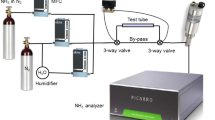Abstract
An in-house set-up was developed for determining the permeability of, paint films towards carbon dioxide. The system implemented the so-called Wicke-Kallenback method, described in EN 1062-6. This method consists of a two-chamber permeation cell divided by a supported paint film. A carbon dioxide/nitrogen mixture stream (15% CO2/85% N2) is fed to the retentate chamber and a nitrogen carrier stream is fed to the permeate chamber. Carbon dioxide permeates from the retentate to the permeate chamber. The carbon dioxide flow rate is obtained from the permeate concentration and flow rate. From the carbon dioxide flow rate it is possible to calculate the paint film permeability towards this gas. The coating system is applied on a Kraft paper support sheet; the Kraft paper by itself shows negligible permeation, resistance.
Coatings to be considered as “surface protection systems for concrete” must comply with EN 1504-2. This standard requires that the paint film permeability have an equivalent air thickness of SD≥50 m. The unit developed was able to quickly determine permeabilities as low as an equivalent air thickness of SD=1500 m.
Similar content being viewed by others
References
Viness, T.L. and Manager, P.E., “Architectural Coatings for Repair and Protection of Concrete Facades”, Materials and Construction: Exploring the Connection: Proceedings of the 5th ASCE Materials Engineering Congress, Cincinnati, OH, 232–239, 1999.
EN 1504-2, “Products and Systems for the Protection and Repair of Concrete Structures—Definitions, Requirements, Quality Control and Evaluation of Conformity—Part 2: Surface Protection Systems for Concrete”, April 2004.
International Report, “Design Manual for Roads and Bridges,” Volume 2, Section 4, Part 3, A/6, May 2004.
Jerga, J., “Physico-Mechanical Properties of Carbonated Concrete”, Construction and Building Materials, Vol. 18, 645–652, 2004.
EN 1062-6, “Paints and Varnishes—Coating Materials and Coating Systems for Exterior Masonry and Concrete—Part 6: Determination of Carbon Dioxide Permeability”, 2004.
Ruthven, D., Principles of Adsorption and Adsorption Processes, John Wiley & Sons, NY, 1984.
Mulder, M., Basic Principles of Membrane Technology, Kluwer Academic Publishers, Dordrecht, 2nd Ed., 1996.
Bird, R., Stewart, W., and Lightfoot, E., Transport Phenomena, John Wiley & Sons, NY, 2nd Ed., 2001.
Internal information at GKSS-Geesthacht, Germany, 1994.
Pixton, M., Paul, D., and Yampol’skii, Y., “Relationships Between Structure and Transport Properties for Polymers with Aromatic Backbones”, in Polymeric Gas Separation Membranes, Paul, D. and Yampol’skii, Y. (Eds.), CRC Press, Boca Raton, FL, 1994.
Author information
Authors and Affiliations
Corresponding author
Rights and permissions
About this article
Cite this article
Carneiro, C., Oliveira, F., Nogueira, J. et al. Determining the carbon dioxide permeability of paint films. J Coat. Technol. Res. 3, 323–326 (2006). https://doi.org/10.1007/s11998-006-0029-y
Published:
Issue Date:
DOI: https://doi.org/10.1007/s11998-006-0029-y




